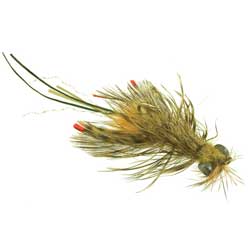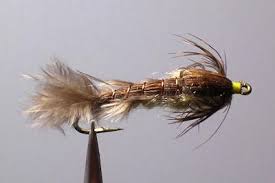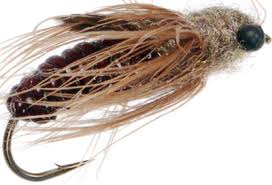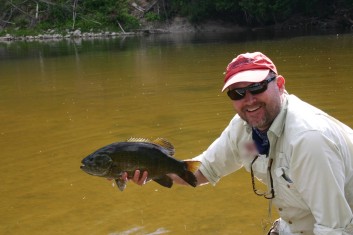We slid into the top of the flats as quietly as we could manage in a big Mackenzie River drift boat and I slowly lowered the anchor. This stretch of the Saugeen River is a long, uniform run with a vast shelf that runs for about 200 yards along the right side of the river. When the sun is just right and in low, clear conditions, it’s easy to spot bass from a great distance. I got out of the boat and took up the anchor from the stern and began walking the craft slowly down stream while Paul kept an eye open for cruising fish.
“There.” He whispered. “There, about 80 feet out at 2 o’clock. Three big fish.”
I couldn’t see them as I was too low but I had the general direction and eased the boat into casting position. Paul is a better than average angler and can get the job done most of the time but this morning was tough. Conditions were good as far as water levels and clarity went but a cold snap from the night before had dropped the temperature by 8 degrees (C) and the smallmouth were not cooperating one bit. When I guide for bass, I typically start with poppers for no other reason then that it’s just enjoyable and it helps me to get a feel for what kind of mood they are in and then you adjust from there. In the early morning, we hit the banks with several different surface baits but when we found the fish were simply “off”, we started to adapt. We fished weighted patterns like Clouser Minnows, Murray’s Hellgrammits and the like but for our efforts, we took only two small fish.
Now, with the sun high and the river clear, we began spotting fish and took a different approach. Sight fishing for any fish is exhilarating but can also be extremely technical as the old adage is never truer, “If you can see them, they can see you.” My spin on that thought is, “If you can spot them first, you at least have a chance.” I explained to Paul that we would take a finesse approach for the fish in the open and that a combination of stealth and accurate casting would prevail.
It is a common misconception, I believe, that bass are “easy” to fool. In fact, if given the choice, I’d rather fish for trout during cold fronts or fluctuating temperatures than bass any day of the week. At least during a cold front you know that trout will continue to eat. They may slow down and become selective but you at least have a fighting chance. In a bass river, temperatures from late August through to September can and often do fluctuate as much as six or eight degrees (Celsius) over night and this can and often does simply put the fish off. They just won’t eat. They may look at your fly very casually but frequently enough, they will show little interest in conventional bass patterns like large streamers or poppers. When this happens, it pays to become more “trouty”.
I lengthened Paul’s leader to 12 feet and reduced the tippet to 4X fluorocarbon which would deliver a nice, delicate cast that should be less disturbing. The trick here is to locate the fish and get a feel for which direction they are cruising and then time your cast to intercept their path. The pattern that I chose is sort of cross between a very small cray fish and a hexagenia nymph.

Small Crayfish, hex nymphs, dragon flies or any combination of those patterns will often make the difference after cold fronts.
I tie the pattern “Clouser” style with tiny lead eyes so that is swims but more importantly, sits hook up on the bottom mitigating snag on rocks and wood.
It’s not fool proof but works pretty well. I brought the boat to within 60 feet as Paul began to set up his cast. It’s much like bonefishing in that you need to be accurate on the first cast for if you spook them, you may as well just move on. I could see two of the fish now and instructed Paul to put a cast about 15 feet ahead of the lead bass. The rivers current would move the fly towards the fish as it sank and should deposit it perfectly in proximity of their path. Paul nailed the first cast and even put a little up stream reach into the line so that the fly would sink without being pulled away. The fly hit softly but with just enough of a disturbance that the lead fish immediately began searching. We watched the entire affair unfold and no matter how often you see this kind of thing, it never gets old. The fly sank gradually and was in perfect line with the fish. He moved towards it and turned perpendicular to the current, reversing his direction as the fly drifted past. Then, as the fly hit the substrate he bowed down and sucked it up. Nothing aggressive, just a subtle tail up, head down take. Paul didn’t feel anything but when he was convince the fly had been eating, he lifted the rod tip. The smallmouth reacted just as you would expect, jumping, running and dogging like its life was endangered but the 4X tippet held and I netted the fish a couple of minutes later.
This was a tough day but we were able to repeat this scenario five more times during the day and I’d go out on a limb and say that the 5 of the 6 fish that we bested would have competed in any bass tournament in the province. Six tough smallmouth are rewarding on a day when conditions were extreme.
We tried other techniques when we could not sight fish but the bass were not into working hard so we kept the cray/hexagenia pattern tied on a 5wt and every time that we saw fish, we induced some interest and in the end, it was flat out fun!
The point to this is that we recognized that the fish were off and adapted to it. We often find smallmouth bass to be aggressive and cooperative and when they are, they are some of the best sport a fly fisher can have. Conversely though, they can be down right tough and simply won’t eat. Conventional thinking may produce the odd fish but when you are sitting on a cold front, you need to slow things down and give the fish a reason to eat. A three inch Clouser minnow may get their attention but in the end, it is too much work for them. A size 12 nymph tumbling towards them though that can’t escape is often just the ticket and will be the difference.



